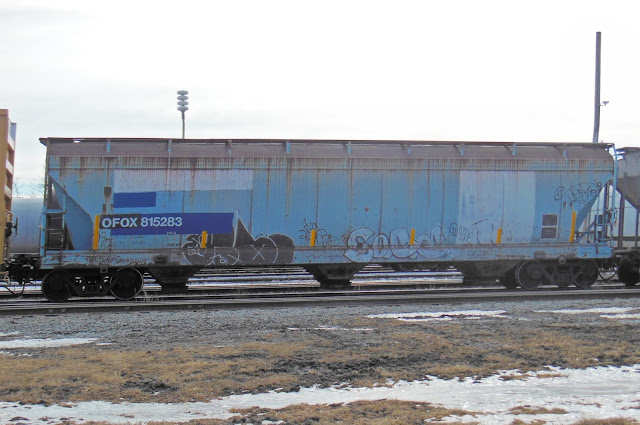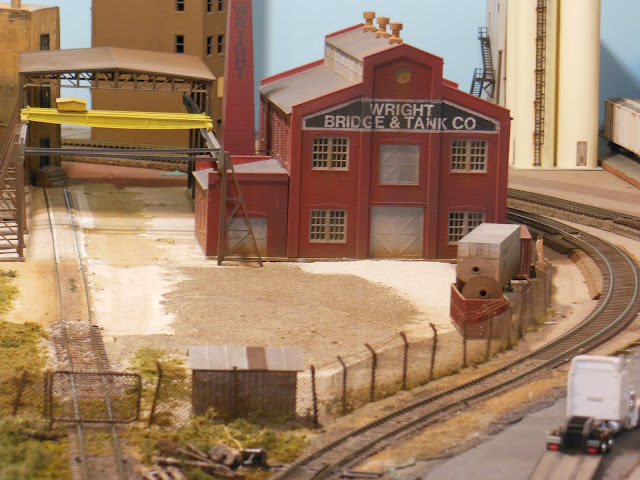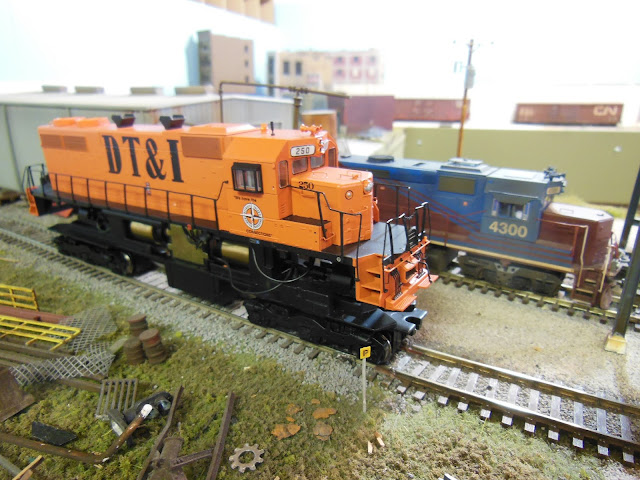One of my favourite engines to run on the layout is my blue Grand Trunk Western SD38, which sees almost constant use. I once saw an identical engine for sale at a train show and didn't buy it. I've often thought that I really made a mistake that time, and should have picked that one up. The number was the same, but I could have changed that without too much trouble.
My GTW SD38 rounding a curve
I like the GTW and the jumbo sized auto parts boxcars that used to be seen around my area. They had five SD38's, numbers 6250 - 6254, all were previously owned by the Detroit, Toledo and Ironton. My understanding is that when GT acquired their DT&I locomotives, GT simply added the number "6" prefix to the DT&I numbering system.
A couple of years ago, trouble began with this particular model of mine though, as the motor would sort of grind a bit and sometimes would just stop altogether. I opened it up, and found the motor pretty difficult to spin by hand.
My solution at that time was to pull the motor from another SD38 I have, which I didn't really use very much. This one is painted in the orange and black scheme of the Detroit, Toledo, and Ironton. I figured this would get my GTW engine up and running properly and then I'd worry about getting a replacement motor for the DT&I model.
So I called Athearn one January morning last year, and ordered a replacement motor right over the phone. The guy there told me that it might be 3 weeks or so until they'd ship it out. I was okay with that and told him so, he took my cc information and that was that. As I said that was over a year ago now.
I'm still waiting.
However, I rather recently happened to find the correct motor available on the Horizon Hobby website a few weeks ago, so I ordered it on line. It arrived in the mail about a week and a half later. Yay!
The DT&I body shell, frame/chassis, and the new motor.
The replacement motor basically dropped right in.
The new motor is installed here (that was easy enough) along with a basic 4 function plug-in decoder (made by ESU), and can be seen dangling loosely at the left hand end in this photo.
So, over to the programming track. I thought it might be a wise move to program the new decoder before I put the shell back on the frame, just in case of some problem arising (none did).
The DT&I engine on the programming track, located beside the JSSX maintenance building. The insulated rail joiners that separate the programming track from the rest of the layout are sort of visible right in front of the wheels. The yellow sign with the letter "P" is also indicative of where the programming section begins.
Here's DT&I 250 back in service and hauling a few 86 foot auto parts cars. It has an orange beacon light on the cab roof. The beacon lights up when the headlights are turned on. It's a bit difficult to see against the orange of the locomotive itself. I'm not that crazy about it.
The gong style of bell on the nose of the engine is/was a neat feature of the DT&I, but could use windshield wipers installed and doesn't really belong out on the layout at all without at least some weathering too.
The two SD38's together. The spark arrestors on the DT&I model are interesting. I'd imagine that the prototype 6252 would have had them originally as well. I really ought to try to look into that and if so, try to add them as well.



















